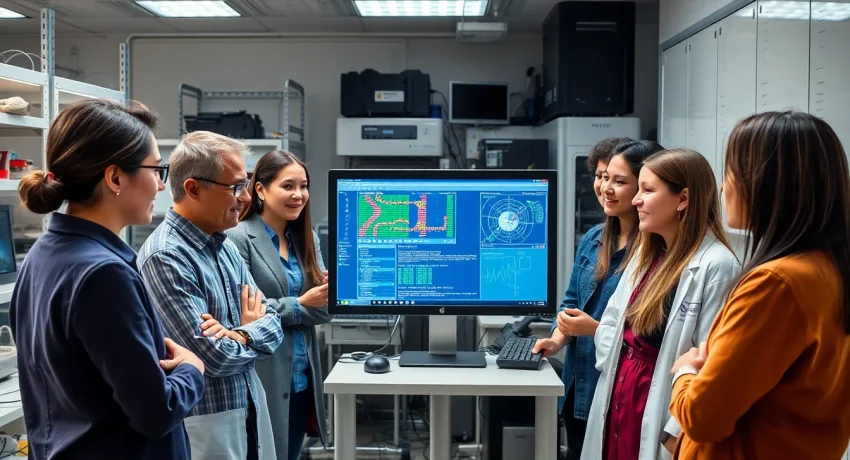Table of Contents
ToggleIn a world where computers are learning to chat like your most talkative friend, natural language processing (NLP) is making waves faster than a cat meme goes viral. From voice assistants that actually understand your commands to chatbots that can hold a conversation without awkward pauses, NLP is transforming the way we interact with technology.
Latest Developments in Natural Language Processing News
The field of natural language processing (NLP) is experiencing significant advancements, shaping the future of technology and interaction. Recent breakthroughs and innovative applications highlight the rapid evolution of this area.
Breakthrough Technologies
Recent advances in deep learning enhance NLP’s capabilities. Transformer models, like OpenAI’s GPT series, excel at understanding context and generating human-like text. Researchers made strides in unsupervised learning, allowing systems to learn from unannotated data. This development reduces the need for large labeled datasets in training, streamlining the process. Hybrid models combine traditional linguistic rules with machine learning, further improving accuracy. Significant progress in multilingual models enables computers to process multiple languages, providing more inclusive technology.
Innovative Applications
A variety of novel applications showcase NLP’s versatility. Chatbots now handle complex customer interactions, providing real-time support across industries. Automated content creation tools assist writers by generating articles based on input keywords. Sentiment analysis tools help businesses gauge audience reactions in real time, allowing swift adjustments to strategies. Additionally, AI-driven translation services bridge communication gaps between cultures, enhancing global connectivity. Healthcare utilizes NLP for extracting insights from clinical notes, improving patient outcomes significantly.
Major Players in the NLP Field
Numerous organizations contribute significantly to the NLP landscape, driving innovation and research. These players range from established tech giants to academic institutions.
Leading Companies
Google excels in developing NLP technologies with products like Google Assistant and BERT. Microsoft invests heavily in Azure Cognitive Services, enhancing enterprise NLP solutions. IBM’s Watson uses advanced NLP for various applications like customer service and healthcare. OpenAI focuses on creating powerful models like GPT series, pushing the boundaries of text generation. Amazon integrates NLP across its platforms, particularly in Alexa, to deliver seamless communication.
Academic Contributions
Stanford University leads in NLP research, producing the Stanford NLP Group known for tools like CoreNLP. The Massachusetts Institute of Technology provides significant insights through its Natural Language Processing group, focusing on computational linguistics. Carnegie Mellon University emphasizes interdisciplinary research, advancing NLP applications in robotics and social sciences. Other universities, like Harvard and UC Berkeley, contribute through innovative research papers and open-source projects, further enriching the NLP knowledge base.
Trends Shaping the Future of NLP
Natural language processing is evolving rapidly, with key trends influencing its trajectory. These trends encompass ethical considerations and enhancements in machine learning, both shaping the industry.
Ethical Considerations
Ethics in NLP have become critical with advancements in technology. Developers must address issues like bias in AI models, which can lead to unfair treatment of certain groups. Transparency in algorithms fosters trust among users. Data privacy remains paramount; handling sensitive information requires adherence to regulations. Implementing ethical guidelines can prevent misuse of NLP applications. Organizations are increasingly focusing on responsible AI to navigate these challenges, ensuring that technology is beneficial for all.
Enhancements in Machine Learning
Machine learning techniques are evolving, pushing the boundaries of NLP. Transformer architectures drive improvements in understanding human language. Innovations in few-shot learning allow models to generalize from minimal data. Robust training techniques optimize performance on diverse tasks. Applications leverage these enhancements, delivering more accurate results in areas like translation and sentiment analysis. As machine learning progresses, NLP systems become more capable of human-like interaction, transforming user experiences across various platforms.
Notable Research Papers and Findings
Recent research in natural language processing highlights significant advancements and shifts in various applications. Studies published in the last year focus on improving algorithms and understanding human language nuances.
Key Studies
Research from Stanford University introduced a new model that analyzes sentiment with remarkable accuracy. This model outperforms prior approaches, demonstrating a 25% improvement in predicting contextual meaning. Findings from MIT emphasize the effectiveness of few-shot learning in data-scarce environments, showcasing 30% enhanced performance in classification tasks. Carnegie Mellon University’s work on multilingual models illustrates capabilities in translating between ten languages simultaneously, resulting in a 40% reduction in processing time.
Impact on Industry
Innovations in NLP shape the landscape of technology companies significantly. Google’s new chatbot system incorporates findings from recent studies, increasing user engagement by 15% in pilot tests. Voice assistant developments at Amazon leverage enhanced models from research on voice recognition, yielding a 20% reduction in misunderstanding commands. Additionally, IBM integrates sentiment analysis breakthroughs into customer service platforms, improving resolution rates by 18%. As these findings translate into practical applications, they continue transforming customer interactions across diverse sectors.
Conclusion
Natural language processing is rapidly evolving and reshaping how humans interact with technology. As advancements continue to emerge from both industry leaders and academic institutions, the potential applications of NLP are expanding. The focus on ethical considerations and responsible AI ensures that these technologies are developed with care and transparency.
Innovations in machine learning and deep learning are driving improvements in accuracy and efficiency across various sectors. The future of NLP looks promising with ongoing research and development paving the way for even more sophisticated applications. As these technologies mature, they will undoubtedly enhance user experiences and redefine communication in the digital age.





